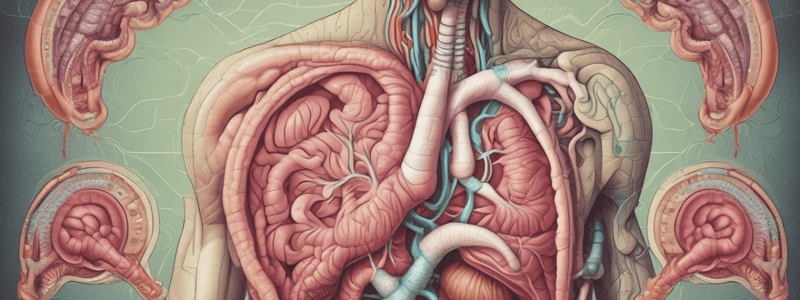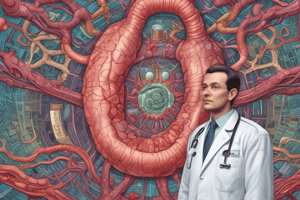Podcast
Questions and Answers
Match the following terms with their corresponding descriptions:
Match the following terms with their corresponding descriptions:
GERD = Chronic reflux of GI contents into the esophagus Hiatal Hernia = Stomach herniation into the esophagus and diaphragm Dysphagia = Difficulty in swallowing Motility problems = Abnormal movement of food through the digestive system
Match the following clinical manifestations with their corresponding conditions:
Match the following clinical manifestations with their corresponding conditions:
Heartburn = GERD Angina-like chest pain = Hiatal Hernia Esophageal irritation = GERD Respiratory symptoms = Hiatal Hernia
Match the following diagnostic tests with their corresponding purposes:
Match the following diagnostic tests with their corresponding purposes:
Endoscopy = Visual examination of the esophagus and stomach Mucosal Biopsy = Examination of esophageal tissue for inflammation Barium Swallow (UGI) = Imaging of the esophagus and stomach Esophageal pH monitoring = Measurement of acid levels in the esophagus
Match the following interprofessional and nursing management strategies with their corresponding goals:
Match the following interprofessional and nursing management strategies with their corresponding goals:
Match the following terms with their corresponding definitions:
Match the following terms with their corresponding definitions:
Match the following complications with their corresponding conditions:
Match the following complications with their corresponding conditions:
Match the following medications with their corresponding purposes:
Match the following medications with their corresponding purposes:
Match the following terms with their corresponding descriptions:
Match the following terms with their corresponding descriptions:
Match the following terms with their corresponding gastrointestinal disorders:
Match the following terms with their corresponding gastrointestinal disorders:
Match the following symptoms with their corresponding gastrointestinal manifestations:
Match the following symptoms with their corresponding gastrointestinal manifestations:
Match the following diagnostic studies with their corresponding uses:
Match the following diagnostic studies with their corresponding uses:
Match the following interprofessional and nursing care strategies with their corresponding goals:
Match the following interprofessional and nursing care strategies with their corresponding goals:
Match the following gastrointestinal conditions with their corresponding complications:
Match the following gastrointestinal conditions with their corresponding complications:
Match the following medical interventions with their corresponding uses in gastrointestinal care:
Match the following medical interventions with their corresponding uses in gastrointestinal care:
Match the following anatomical locations with their corresponding gastrointestinal disorders:
Match the following anatomical locations with their corresponding gastrointestinal disorders:
Match the following etiologies with their corresponding gastrointestinal disorders:
Match the following etiologies with their corresponding gastrointestinal disorders:
Match the following complications of cirrhosis with their descriptions:
Match the following complications of cirrhosis with their descriptions:
Match the following liver diseases with their causes:
Match the following liver diseases with their causes:
Match the following symptoms of cirrhosis with their causes:
Match the following symptoms of cirrhosis with their causes:
Match the following complications of cirrhosis with their effects on the body:
Match the following complications of cirrhosis with their effects on the body:
Match the following terms related to cirrhosis with their definitions:
Match the following terms related to cirrhosis with their definitions:
Match the following symptoms of cirrhosis with their underlying mechanisms:
Match the following symptoms of cirrhosis with their underlying mechanisms:
Match the following complications of cirrhosis with their effects on the liver:
Match the following complications of cirrhosis with their effects on the liver:
Match the following terms related to cirrhosis with their effects on the body:
Match the following terms related to cirrhosis with their effects on the body:
Match the following symptoms of cirrhosis with their underlying causes:
Match the following symptoms of cirrhosis with their underlying causes:
Match the following complications of cirrhosis with their effects on the gastrointestinal system:
Match the following complications of cirrhosis with their effects on the gastrointestinal system:
Match the following gastrointestinal disorders with their primary symptoms:
Match the following gastrointestinal disorders with their primary symptoms:
Match the following inflammatory disorders with their etiologies:
Match the following inflammatory disorders with their etiologies:
Match the following diagnostic tests with their corresponding disorders:
Match the following diagnostic tests with their corresponding disorders:
Match the following medications with their uses in gastrointestinal disorders:
Match the following medications with their uses in gastrointestinal disorders:
Match the following surgical management options with their corresponding disorders:
Match the following surgical management options with their corresponding disorders:
Match the following complications with their corresponding disorders:
Match the following complications with their corresponding disorders:
Match the following nutritional management options with their corresponding disorders:
Match the following nutritional management options with their corresponding disorders:
Match the following liver diagnostic tests with their corresponding results:
Match the following liver diagnostic tests with their corresponding results:
Match the following inflammatory disorders with their risk factors:
Match the following inflammatory disorders with their risk factors:
Match the following symptoms with their corresponding disorders:
Match the following symptoms with their corresponding disorders:
Flashcards are hidden until you start studying
Study Notes
Gastroesophageal Reflux Disease (GERD)
- Chronic reflux of gastrointestinal contents into the esophagus
- Causes:
- Incompetent lower esophageal sphincter (LES)
- Pyloric stenosis
- Hiatal hernia
- Delayed emptying
- Motility problems
- Clinical manifestations:
- Heartburn
- Substernal and retrosternal pain
- Indigestion
- Acid regurgitation
- Esophageal irritation
- Dysphagia
- Angina-like chest pain
- Respiratory problems
Complications of GERD
- Esophagitis
- Esophageal scarring and strictures
- Airway inflammation, aspiration, and scarring
- Barrett's esophagus
- Metaplasia of epithelials in the lower esophagus
- Risk factor for esophageal cancer
Diagnostic Tests for GERD
- Endoscopy
- Mucosal biopsy
- Barium swallow (upper GI series)
- Fluoroscopy/X-ray
- Motility studies
- Esophageal pH monitoring
Interprofessional and Nursing Management of GERD
- Diet: low-fat, high-fiber, high water concentration
- Avoid foods that increase acid production
- Stop smoking
- Maintain a healthy weight
- Avoid eating two hours before bedtime
- Elevate the head of the bed (HOB)
- Medications: antacids, H2 antagonists, and proton pump inhibitors (PPIs)
Hiatal Hernia
- Stomach herniation into the esophagus and diaphragm
- 2 types: sliding and paraesophageal
- Clinical manifestations:
- Similar to GERD
- Etiology and pathophysiology:
- Structural: weakened muscle in the diaphragm and esophagogastric opening
- Increased intra-abdominal pressure
- Complications:
- GERD
- Esophagitis
- Ulcers
- Hemorrhage
- Strangulation
- Aspiration
- Diagnostic studies:
- Same as GERD
- Nursing and interprofessional management:
- Improve the cause of increased intra-abdominal pressure
- Symptom management
- Pain control
- Stomach acid control
- Surgical repair (herniotomy, herniorrhaphy, fundoplication, gastropexy)
Bowel Obstructions
- Clinical manifestations:
- Nausea and vomiting
- Pain (colicky or visceral)
- Interruption in bowel habits
- Abdominal distension
- Changes in bowel sounds (BST)
- Complications:
- Atelectasis
- Malnutrition
- Hypovolemia
- Rupture
- Infection (peritonitis)
- Types of bowel obstructions:
- Functional (ileus)
- Mechanical (simple)
- Pyloric
- Intestinal (more common in the small bowel)
- Diagnostic studies:
- Abdominal X-rays
- CT scan
- Contrast oral/enema
- Sigmoidoscopy or colonoscopy
- Blood tests (CBC, metabolic panel)
Gastric Disorders
- Typical clinical manifestations:
- Nausea and vomiting
- Pain
- Hemorrhage
- Anorexia
- Weight loss
- Flatus
- Complications:
- Neoplasm
- Hypovolemia
- Perforations
- Obstruction
Peptic Ulcers
- Epigastric mucosal "craters"
- Mucosal damage and increased presence of acid and/or pepsin
- Common etiologies:
- Stress
- H. pylori
- NSAIDs
- MOA:
- Inflammation
- Cytokine damage
- H. pylori toxins
- Nursing considerations and interventions:
- Manage pain
- Control stomach acid
- Prevent complications
Inflammatory Disorders
- Etiologies:
- Increased immune sensitivities to intestinal flora
- Epithelial dysfunction
- Epigenetics
- Most common: Crohn's disease and ulcerative colitis
- Irritable bowel syndrome (IBS):
- "Brain-gut" disorder
- Increased incidence with stress, anxiety, and depression
- Symptoms:
- Abdominal bloating and distension
- Pain
- Increased flatus
- Diarrhea or constipation
- Nausea
- Relieved with passing flatus and bowel movement, treat underlying etiologies (e.g., coping, diet, etc.)
Ulcerative Colitis
- Inflammation and ulceration of the mucosa and submucosa of the colon
- Clinical manifestations:
- Loose stools with blood and mucus
- Malabsorption
- Thickening/scarring of the colon wall
- Other symptoms:
- Hemorrhage
- Strictures
- Perforation
- Toxic megacolon
- Colonic dilation
- Diagnostic tests:
- CBC
- Electrolytes
- Serum protein levels
- Stool cultures
- Sigmoidoscopy and/or colonoscopy
- Biopsy specimens
- Nonsurgical management:
- Rest the bowel
- Control inflammation
- Combat infection
- Correct malnutrition
- Stress management
- Symptomatic relief
- Medication therapy:
- Corticosteroids
- Antidiarrheal drugs
- Antibiotics
- Surgical management:
- Colectomy (partial or total)
- Pouch system
- Total colectomy with a continent (Kock's) ileostomy
- Total colectomy with ileoanal anastomosis (J pouch)
Crohn's Disease
- Idiopathic inflammatory disease
- Affects the full thickness of the small intestine and/or the colon
- Affects any part of the GI tract from the mouth to the anus
- Complications:
- Fat and/or gluten intolerance
- Bowel wall thickening
- Strictures and obstruction
- Abscesses or fistulas
- Malabsorption of vitamins and nutrients
- Clinical manifestations:
- Nonspecific complaints
- Diarrhea (non-bloody)
- Constipation
- Abdominal pain
- Fatigue
- Fever
- Weight loss
- Diagnostic tests:
- Laboratory studies
- Endoscopy with biopsy
- Upper GI barium studies
- Nonsurgical management:
- Nutrition
- Medication therapy
- Symptom management
- Fluid and electrolyte therapy
- Skin care
- Surgical management:
- Not curative
- Small bowel resection and ileocecal resection
- Stricturoplasty
Diverticulitis
- Diverticulosis: outpouchings in the intestinal walls (diverticula)
- Diverticulitis: inflammation of diverticula
- Cause: (believed) chronic low fiber diet
- Risk factors:
- Age
- Gender
- Clinical manifestations:
- Intermittent left lower quadrant (LLQ) pain
- Constipation
- Diverticulitis:
- Low-grade fever
- Nausea
- Abdominal pain
- Constipation
- Rectal bleeding
- Abdominal distension
- Rebound tenderness
- Symptoms of diverticular perforation:
- Tender mass in the rectal area
- Hypotension
- Dehydration
Liver Disorders
- Diagnostic tests for liver diseases:
- Serum labs
- Liver biopsy (gold standard)
- Abdominal X-ray/CT scan
- MRI
- Ultrasound (US)
- Endoscopic retrograde cholangiopancreatography (ERCP)
- Liver disease (cirrhosis):
- Regenerative properties decline and/or inhibited
- Fibrotic tissue
- Vascular restructuring and alternative pathways
- Portal hypertension
- Causes:
- Alcohol
- Hepatitis
- Viral
- Autoimmune
- Drugs and toxins
- Liver cancers
- Biliary disease
- Genetics
- Nonalcoholic fatty liver
- Clinical manifestations:
- Early:
- Anorexia
- Dyspepsia
- Increased flatulence
- Nausea and vomiting
- Change in bowel habits
- RUQ and/or epigastric pain
- Edema
- Hepatic stretching
- Fever
- Weight loss
- Later:
- Jaundice
- Peripheral edema and ascites
- Pruritis
- Skin lesions
- GI bleed
- Hepatic encephalopathy
- Hepatorenal syndrome
- Portal hypertension
- Early:
- Complications:
- Portal hypertension
- Ascites
- Esophageal varices
- Jaundice
- Encephalopathy
Studying That Suits You
Use AI to generate personalized quizzes and flashcards to suit your learning preferences.



